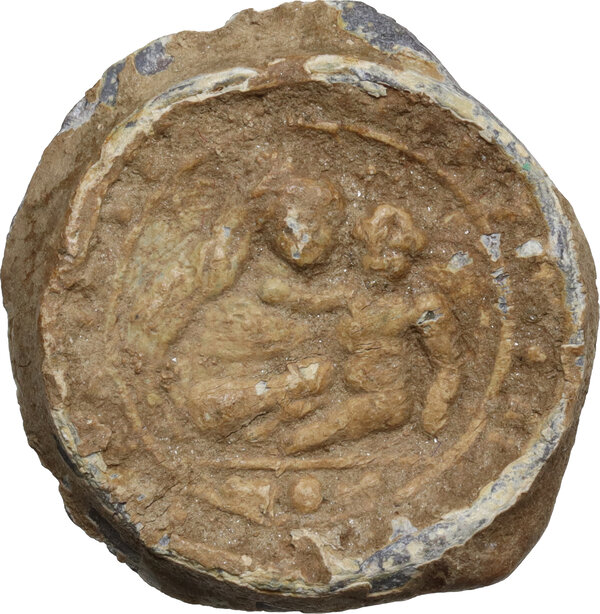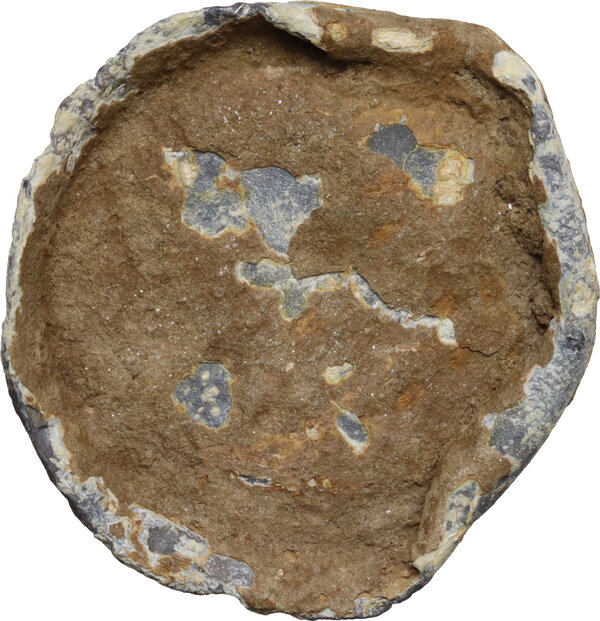

Lotto 1077:
Lead Theriac lid.
Bust of Madonna holding the infant Christ.
Venice, Alla Spatiaria Pharmacopia.
17th century. 8.60 g. 26.50 mm. R. A rare Pharmacopia. Theriaca (also known as ‘Venice treacle’) was an ancient medicinal compound, employed as a traditional medicine since the time of Mithradates VI of Pontus, and was used as antidote against any poisonous bite. Nero’s physician Andromachus, as well as the medical author Galen, discussed its medicinal value. Containing more than 64 ingredients, including viper flesh and opium, as well as herbs, cinnamon, agarics, and gum arabic, it was mixed with honey and wine to complete the compounding process. During the Middle Ages it was considered a panacea. Theriac became a valuable article of commerce, with Venice, Padua, Milan, Genoa, Bologna, Constantinople, and Cairo all competing in its trade. It was expensive and hence available only for the rich (quality theriac cost one German taler in 1580s). By the time of the Renaissance, the making of theriac had become an official public ceremony, especially in Italian cities. It is first mentioned in England in 1538, and it gained popularity in Germany around the same time. Pharmacists sold it as late as 1900.
Venice regulated the production and trade of theriac beginning in 1258, and by the fifteenth century controlled its distribution throughout Europe. About 40 pharmacy shops in Venice were officially allowed to produce and sell theriac. (CNG, auction 90, 03.05.2012).
Bust of Madonna holding the infant Christ.
Venice, Alla Spatiaria Pharmacopia.
17th century. 8.60 g. 26.50 mm. R. A rare Pharmacopia. Theriaca (also known as ‘Venice treacle’) was an ancient medicinal compound, employed as a traditional medicine since the time of Mithradates VI of Pontus, and was used as antidote against any poisonous bite. Nero’s physician Andromachus, as well as the medical author Galen, discussed its medicinal value. Containing more than 64 ingredients, including viper flesh and opium, as well as herbs, cinnamon, agarics, and gum arabic, it was mixed with honey and wine to complete the compounding process. During the Middle Ages it was considered a panacea. Theriac became a valuable article of commerce, with Venice, Padua, Milan, Genoa, Bologna, Constantinople, and Cairo all competing in its trade. It was expensive and hence available only for the rich (quality theriac cost one German taler in 1580s). By the time of the Renaissance, the making of theriac had become an official public ceremony, especially in Italian cities. It is first mentioned in England in 1538, and it gained popularity in Germany around the same time. Pharmacists sold it as late as 1900.
Venice regulated the production and trade of theriac beginning in 1258, and by the fifteenth century controlled its distribution throughout Europe. About 40 pharmacy shops in Venice were officially allowed to produce and sell theriac. (CNG, auction 90, 03.05.2012).
Base d'asta € 50
Prezzo attuale € 50
Offerte: 1
Lotto non in vendita
Prezzo attuale € 50
Offerte: 1
Lotto non in vendita





